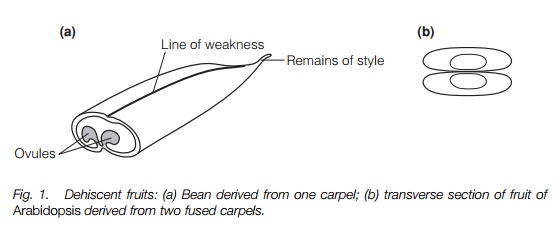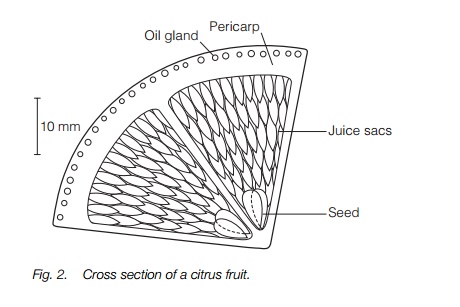Chapter: Plant Biology : Reproductive anatomy
Reproductive anatomy of Fruits
FRUITS
Key Notes
Fruit structure
Fruits are formed from the ovary and sometimes other parts of the carpel or other parts of the flower. Dehiscent fruits usually have a hard wall made partly of sclerenchyma and break along a line of weakness where fusion has happened.
Indehiscent fruits
These may be dry and resemble the seed coat in the one-seeded fruits of grasses and some other plants and dispersed with the seed. Fleshy fruits are variable, some with a complex structure with a separate rind, layers
of different cells and juice-filled parenchyma. When immature, the fruits are often photosynthetic, becoming colored and often with an increase in sugar as they mature.
Dispersal
Many dehiscent fruits simply drop their seeds and have no specialized dispersal. Fleshy fruits may be ingested by vertebrates and the seeds dispersed through defecation or by the animal discarding them. Other indehiscent fruits form burs. Some are dispersed by wind forming a sail. In composites the sepals increase in size to form a feathery dispersal structure.
Fruit structure
The true fruit is a feature only found in the flowering plants since it is formed, at least in part, from the carpel (the so-called ‘fruits’ of conifers such as yew or juniper are fleshy outgrowths from the seeds or cone scales). There are
numerous different shapes, sizes and types of fruits, from water melons and pineapples to dehiscent pods and the dry chaff of a grass. They have been classified in several different ways according to the structures that give rise to them. These always involve the ovaries which may be free or fused, superior or inferior. Sometimes the rest of the carpel develops into part of the fruit as well and other floral parts such as the bases of sepals or petals, or the receptacle may be involved. A few fruits such as the fig and pineapple are derived from a whole inflorescence.
Dehiscent fruits, i.e. those which open to disperse their seeds (Fig. 1), usually have several seeds and the fruit itself often has a protective function as the seeds mature. It may derive from a single carpel as in the pods of peas and other legumes, or from two or more fused together, as in Arabidopsis(Topic E1) and other members of the cabbage family. The outer fruit wall is normally hard and contains one or more layers of sclerenchyma cells mixed with parenchyma, sometimes with the cell layers at different angles. As they dry out the cell layers dry differentially. Lines of weakness occur along the carpel margin or where several carpels fused and these break to disperse the seeds. In many legumes, differential drying in the fruit wall leads to an explosive break and twisting of the two halves of the fruit, dispersing the seeds.

Indehiscent fruits
Many fruits do not dehisce and these may be dry, as in grasses, or fleshy. In dry indehiscent fruits the fruit normally resembles the seed testa and the fruit is dispersed with the seed. The fruit consists solely of one or more layers of sclerenchyma and parenchyma cells, this type being characteristic of grasses, composites (daisy family) and some other families. It may include the ovary wall and part of the receptacle or base of the flower which has become indistinguishable from it. In wheat this wall, along with what remains of the seed integuments, is the bran.
Fleshy fruits have a more complex structure. Some have a rind quite separate from the flesh (e.g. citrus fruits, banana) and most change color, texture and chemical structure as they mature. As one example, citrus fruits (Fig. 2) have an outer cuticle and epidermis over compact parenchyma with oil glands. Inside the epidermis, the white tissue consists of parenchyma with large air spaces and a vascular network, and another epidermal layer lies inside that. The edible segments consist mainly of juice-filled sacs derived from the inner epidermal cells. Other fleshy fruits have no separate rind, such as cherries and tomatoes, and here there is an epidermis and elongated fleshy cells underneath and, in some, an inner lignified layer around the seed. In apples and pears the flesh is derived from the receptacle, while other fruits are derived from the base of the sepals and petals. These grow around the ovary, the ovary itself becoming the core. In the fruits deriving from inflorescences, petals, sepals and flower stalks all swell to aggregate together as the dispersal unit with fleshy cells mixed in with harder epidermal cells and other types.
Many fleshy fruits are green and photosynthetic, either when immature or at maturity (e.g. cucumbers), from chloroplasts in the outer parenchyma or epidermis. These may change to become colored chromoplasts (Topic B3) and produce anthocyanins or carotenoids (Topic D1) as the fruit matures. Other chemical changes involve the production of sugars from more complex polysaccharides. In many plants, the maturation of the fruit involves a fusion of the floral parts that have given rise to them.
Dispersal
Most dehiscent fruits open with a slit or pores and the seeds simply drop out. Such a fruit, without any specialized structures for dispersal, is the commonest type. Many dehiscent fruits of all sizes are like this, but some have a nutritious

seed that is eaten by vertebrates. Some rodents and birds collect large numbers of seeds for storage, often by burying them, thereby dispersing the seeds effectively. Otherwise, with no active dispersal, dormancy of the seeds will mean that they can be dispersed by rain or wind or mud on the feet of animals.
Many indehiscent fruits are dispersed by animals. The smaller fleshy fruits can be ingested whole by mammals or birds, and the seeds will be defecated or regurgitated elsewhere. With larger fruits or those with larger seeds, vertebrates will often discard the seeds. A fleshy surface to the seed has the same effect. Dry indehiscent fruits may disperse by becoming attached to mammals. Burs may be formed by hooked outgrowths from the ovary wall or persistent styles elongating during fruit growth and becoming hooked. The dispersal unit of some grasses is the fruit with surrounding persistent bracts, which enlarge and attach themselves with sharp points or teeth.
Other indehiscent fruits are dispersed by the wind. The fruit may take the form of a sail, as in maples (Acer species) that may be blown for some distance, the fruit spinning as it descends. Many composites have persistent sepals that, when in flower, form a ring of short hairs but as the fruit is set these grow to form an effective feathery sail for dispersal.
Related Topics